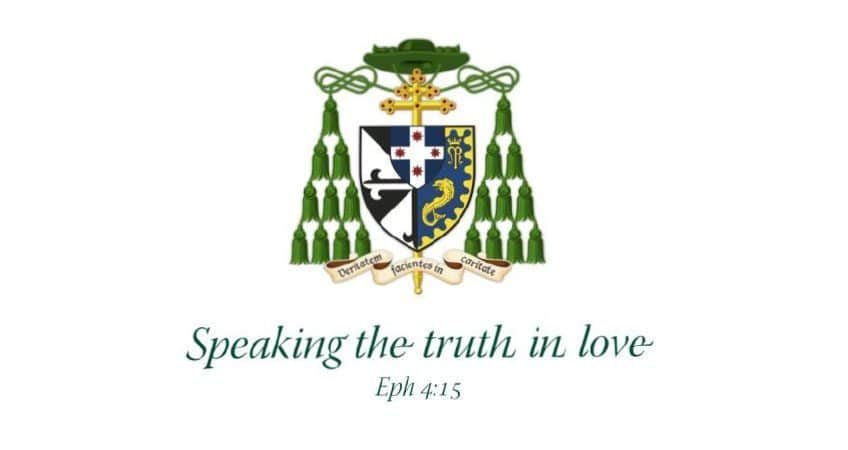HOMILY FOR MASS FOR 2ND SUNDAY OF EASTER(YEAR A)

Livestreamed from St. Mary’s Basilica, Sydney
Painted for the Marchese Vincenzo Giustiani at the beginning of the 17th century, The Incredulity of St Thomas was the most copied of all Caravaggio’s paintings in its day. It now hangs in the Sans Souci Picture Gallery—not in Southern Sydney but in Potsdam, Germany. At Easter Thomas missed the Lord’s appearance to the others and dismissed it as wishful thinking (Jn 20:19-31). “Unless I see the holes that the nails made in his hands and put my finger there, and unless I can put my hand into his side, I refuse to believe,” Thomas said. Now on Low Sunday it’s Thomas’ turn to encounter the Risen Lord. Caravaggio has Jesus pulling open His white robe and guiding Thomas’ wrist towards the wound in His side, the hands becoming a new lance so that we can “look upon the one they have pierced” (cf. Zech 12:10; Jn 19:37). Thomas puts his finger in the hole, while two other apostles—and we—look on.
It’s a fascinating and intimate scene, not least because the artist eschews all surroundings, using only theatrical light and darkness to draw our eyes to what matters most. Here we see empirical man, demanding proof and persuasion, and an indulgent rather than reproachful God, eliciting faith in something greater. All three apostles seem to be looking beyond Christ’s wounds to something else: to Thomas’ declaration ‘My Lord and my God’.
A recent critic punned that Caravaggio’s painting is “one of the most famous pokes in art history” and sympathised with Thomas who is only remembered for his incredulity.[1] Maybe there’s more going on here this morning than a hard-hearted materialist demanding evidence and being scolded for it.
First, when Jesus meets His friends on Easter day, He shows them all His hands and side. So Thomas wasn’t being especially obtuse or Jesus being especially critical. No, what Thomas wanted to verify was this: not just that Jesus was alive, but that it was really Jesus who was alive. Thomas had already seen Jesus’ power over death (e.g. Mk 5:21-43; Lk 7:11-17; Jn ch. 11). He didn’t need to be persuaded of that. Why he wanted to be sure was that this was neither fantasy nor ghost. The ancients believed a soul could wander the earth or the underworld, separated from its body. But Thomas knew that that would be no true human person. No, we are bodily beings: if this is really Jesus who is Risen, Thomas knows it must be the bodily Jesus, however strangely new that body may be.
Here Jesus teaches and Thomas grasps a crucial part of our Christian faith: that the resurrection isn’t about some new us, it’s about making us new, better, best. Thomas’ inquiry is about identity and continuity, and Jesus’ answer is that there is no rupture between the I of this world and the I of the resurrection.
But hold on: Jesus ends with the last and greatest of His beatitudes, “Happy are those who have not seen and yet believe.” So should Thomas have asked his questions and demanded his proofs? Or should he have stopped all the questions and just believed?
Both, of course. Jesus is man and so we can see and touch Him, be inspired by His teaching, impressed by His actions. But Jesus is more than a great man, a revolutionary teacher, a spiritual guru. He is the revelation and power of the unseen God. Thomas sees the man and professes the God. He is an example of an integrated intelligence, of perception, imagination and memory working together to grasp reality, a man of both faith and reason.[2] “Seeing is believing” in the sense that it often precedes and prompts our understanding; but “Believing is seeing” also, seeing more deeply, beyond the obvious and the comfortable.
On 13th August 1967, at St Michael’s Lane Cove, Monsignor Hughy McGuire gave me my First Holy Communion. Sr Mary Eucharia, a Sister of Mercy and my Year 2 teacher, prepared me for the sacrament, teaching me in simple terms that this was the bodily Jesus but also the spiritual God. She thought it would help us to grasp this if we said Thomas’ words ‘My Lord and my God’ at the consecration and more than five decades later I’m still doing so.
What might all this say to us in a time when, as St Peter says today, we are “plagued by all sorts of trials (1Pet 1:3-9). His thought in his epistle is that this is a test of our mettle, and undoubtedly our character and ideals are being tried right now. Peter challenges us to demonstrate more than ordinary human virtue: Christians under pressure must reflect not only Jesus the perfect human being, but also the supernatural faith and hope from Jesus who is God.
If that is true of individual believers in times of trial, it should also be true of the Christian community. So our first reading (Acts 2:42-7) challenges the Church to be faithful to the apostolic teaching if it is to draw more people day by day; to be faithful to the fraternity between its members, so that they share ever more gladly and generously; above all, to be faithful to “the Breaking of the Bread and the [Eucharistic] prayers”. If you can’t celebrate the Eucharist in the Temple, the Acts of the Apostle suggests, do so at home… or by live-streaming you can do both!
Happily we are seeing such natural and supernatural virtue, such human and divine qualities, in spades amongst our people at present. They are finding new ways to share their faith and ideals, to connect with and look after each other, to share and pray. With Thomas and Caravaggio, with Sr Mary Eucharia and the first communion class of 1967 we can say, even from our TV rooms, when we see the elevated host: ‘My Lord and my God’. And from the host He says back to us ‘Blessed are you who have not seen and yet believe.’
INTRODUCTION TO MASS FOR 2ND SUNDAY OF EASTER (YEAR A)
Livestreamed from St. Mary’s Basilica, Sydney
Dear brothers and sisters, last week we celebrated the joy of Christ’s Resurrection. But Easter Day is so big it lasts for eight days and the Easter season for fifty. So today I say to you again: Χριστὸς ἀνέστη! (Ἀληθῶς ἀνέστη!) Christus resurrexit! (Resurrexit vere!) Christ is Risen! (Truly, He is Risen!)
It’s been a strange Easter, our joy marred by separation, our celebration muted by pandemic. In our Gospel today we’ll see that in the first Easter week the apostles were also anxious and incredulous. Even the first Easter wasn’t all chocolate bunnies!
We continue to pray in this Mass for all affected by the pandemic: the dead and grieving, the sick and anxious, elderly and vulnerable; for health professionals and scientists, workers and those out of work, leaders and health authorities; for our loved ones and each other. Though we cannot gather for Mass, we are trying to make our homes true domestic churches, schools of faith and powerhouses of prayer.
That we might with Christ on this Easter Day rise out of the tombs of our sins, let us repent and ask Him for new life.
[1] Slava S, 11 July 2019, https://medium.com/museio/the-story-behind-incredulity-f0444f887598
[2] Cf. Oliver O’Donovan, “Resurrection and the senses: In defence of Thomas”, ABC Religion & Ethics, 12 April 2020 https://www.abc.net.au/religion/oliver-odonovan-resurrection-and-the-sense-defence-of-thomas/12142876

